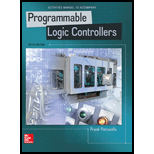
Activities Manual for Programmable Logic Controllers
5th Edition
ISBN: 9781259679568
Author: Petruzella, Frank
Publisher: MCGRAW-HILL HIGHER EDUCATION
expand_more
expand_more
format_list_bulleted
Question
Chapter 2, Problem 1RQ
Program Plan Intro
Programmable Logic Controller (PLC):
- Programmable Logic Controller (PLC) is a specialized computer used in industrial segments to control machines and process.
- PLC is program that consists of a set of instructions which resembles the controlling functions needed to perform specific tasks.
- The function of PLC is similar to that of a relay and hence, in an industrial segment a relay is greatly replaced by a suitable PLC.
- When compared to general PC, a PLC is available in small and tiny sizes.
- The basic architecture of a PLC consists of an input-output interface module and a small Central Processing Unit (CPU) that runs by control
programming language.
Expert Solution & Answer
Explanation of Solution
Function of a PLC input interface module:
- The I/O interface module acts as an interface between the field devices and the CPU of the PLC.
- The input interface module of a PLC is the module by which all the input field devices are connected to the CPU of the PLC.
- The main purpose of an input interface module is to get signals from machines or devices.
- Then, those signals are converted into other form of signals that can be used by the controller.
Want to see more full solutions like this?
Subscribe now to access step-by-step solutions to millions of textbook problems written by subject matter experts!
Students have asked these similar questions
using r language
using r language
Compute a Monte Carlo estimate of
0.8
by sampling from Uniform(0,0.8) and estimate the variance of ⑦.
Chapter 2 Solutions
Activities Manual for Programmable Logic Controllers
Ch. 2 - Prob. 1RQCh. 2 - What is the function of a PLC output interface...Ch. 2 - Prob. 3RQCh. 2 - Prob. 4RQCh. 2 - Prob. 5RQCh. 2 - Prob. 6RQCh. 2 - Prob. 7RQCh. 2 - Prob. 8RQCh. 2 - Prob. 9RQCh. 2 - Prob. 10RQ
Ch. 2 - Prob. 11RQCh. 2 - What are the advantage and the disadvantage of...Ch. 2 - With reference to PLC discrete input modules: a....Ch. 2 - Prob. 14RQCh. 2 - Explain the function of the backplane of a PLC...Ch. 2 - Prob. 16RQCh. 2 - Prob. 17RQCh. 2 - Prob. 18RQCh. 2 - What electronic element can be used as the...Ch. 2 - With reference to discrete output module current...Ch. 2 - What electronic element can be used as the...Ch. 2 - Prob. 22RQCh. 2 - Prob. 23RQCh. 2 - Prob. 24RQCh. 2 - Prob. 25RQCh. 2 - Prob. 26RQCh. 2 - Prob. 27RQCh. 2 - Prob. 28RQCh. 2 - Prob. 29RQCh. 2 - Explain the difference between a unipolar and...Ch. 2 - Prob. 31RQCh. 2 - In what two ways can the loop power for current...Ch. 2 - Prob. 33RQCh. 2 - Prob. 34RQCh. 2 - Prob. 35RQCh. 2 - Write a short explanation for each of the...Ch. 2 - Write a short explanation for each of the...Ch. 2 - Prob. 38RQCh. 2 - Prob. 39RQCh. 2 - Prob. 40RQCh. 2 - Prob. 41RQCh. 2 - Prob. 42RQCh. 2 - Prob. 43RQCh. 2 - Prob. 44RQCh. 2 - Prob. 45RQCh. 2 - Prob. 46RQCh. 2 - Prob. 47RQCh. 2 - What information is normally stored in the ROM...Ch. 2 - Prob. 49RQCh. 2 - Prob. 50RQCh. 2 - Prob. 51RQCh. 2 - Prob. 52RQCh. 2 - Prob. 53RQCh. 2 - Prob. 54RQCh. 2 - Prob. 55RQCh. 2 - Prob. 56RQCh. 2 - Prob. 57RQCh. 2 - Prob. 58RQCh. 2 - Prob. 59RQCh. 2 - Prob. 60RQCh. 2 - What is the function of a transducer?Ch. 2 - Prob. 62RQCh. 2 - Prob. 1PCh. 2 - Assume a thermocouple, which supplies the input to...Ch. 2 - With reference to I/O module specifications: a. If...Ch. 2 - Prob. 4PCh. 2 - Prob. 5PCh. 2 - Prob. 6P
Knowledge Booster
Similar questions
- Write a C program using embedded assembler with a function to convert a digit (0 – 15) to the corresponding ASCII character representing the value in hexadecimal. For numbers 0 – 9, the output will be the characters '0' – '9', for numbers 10 – 15 the characters 'A' – 'F'. The entire core of the program must be written in symbolic instruction language; arrays may not be used. You may only use C to print the result. Tip: This piece of C program will do the same thing: character = number < 10 ? number + '0' : number + 55; As a basis, you can use this program again , which increments a variable. Just replace the INC instruction with ADD and add a test (CMP) with some conditional jump.arrow_forwardAnswer the question fully and accurately by providing the required files(Java Code, Two output files and written answers to questions 1-3 in a word document)meaning question 1 to 3 also provide correct answers for those questions.(note: this quetion is not graded).arrow_forward.NET Interactive Solving Sudoku using Grover's Algorithm We will now solve a simple problem using Grover's algorithm, for which we do not necessarily know the solution beforehand. Our problem is a 2x2 binary sudoku, which in our case has two simple rules: •No column may contain the same value twice •No row may contain the same value twice If we assign each square in our sudoku to a variable like so: 1 V V₁ V3 V2 we want our circuit to output a solution to this sudoku. Note that, while this approach of using Grover's algorithm to solve this problem is not practical (you can probably find the solution in your head!), the purpose of this example is to demonstrate the conversion of classical decision problems into oracles for Grover's algorithm. Turning the Problem into a Circuit We want to create an oracle that will help us solve this problem, and we will start by creating a circuit that identifies a correct solution, we simply need to create a classical function on a quantum circuit that…arrow_forward
- .NET Interactive Solving Sudoku using Grover's Algorithm We will now solve a simple problem using Grover's algorithm, for which we do not necessarily know the solution beforehand. Our problem is a 2x2 binary sudoku, which in our case has two simple rules: •No column may contain the same value twice •No row may contain the same value twice If we assign each square in our sudoku to a variable like so: 1 V V₁ V3 V2 we want our circuit to output a solution to this sudoku. Note that, while this approach of using Grover's algorithm to solve this problem is not practical (you can probably find the solution in your head!), the purpose of this example is to demonstrate the conversion of classical decision problems into oracles for Grover's algorithm. Turning the Problem into a Circuit We want to create an oracle that will help us solve this problem, and we will start by creating a circuit that identifies a correct solution, we simply need to create a classical function on a quantum circuit that…arrow_forwardAnswer two JAVA OOP problems.arrow_forwardAnswer two JAVA OOP problems.arrow_forward
arrow_back_ios
SEE MORE QUESTIONS
arrow_forward_ios
Recommended textbooks for you
 Systems ArchitectureComputer ScienceISBN:9781305080195Author:Stephen D. BurdPublisher:Cengage Learning
Systems ArchitectureComputer ScienceISBN:9781305080195Author:Stephen D. BurdPublisher:Cengage Learning A+ Guide to Hardware (Standalone Book) (MindTap C...Computer ScienceISBN:9781305266452Author:Jean AndrewsPublisher:Cengage Learning
A+ Guide to Hardware (Standalone Book) (MindTap C...Computer ScienceISBN:9781305266452Author:Jean AndrewsPublisher:Cengage Learning Enhanced Discovering Computers 2017 (Shelly Cashm...Computer ScienceISBN:9781305657458Author:Misty E. Vermaat, Susan L. Sebok, Steven M. Freund, Mark Frydenberg, Jennifer T. CampbellPublisher:Cengage Learning
Enhanced Discovering Computers 2017 (Shelly Cashm...Computer ScienceISBN:9781305657458Author:Misty E. Vermaat, Susan L. Sebok, Steven M. Freund, Mark Frydenberg, Jennifer T. CampbellPublisher:Cengage Learning Principles of Information Systems (MindTap Course...Computer ScienceISBN:9781305971776Author:Ralph Stair, George ReynoldsPublisher:Cengage Learning
Principles of Information Systems (MindTap Course...Computer ScienceISBN:9781305971776Author:Ralph Stair, George ReynoldsPublisher:Cengage Learning A+ Guide To It Technical SupportComputer ScienceISBN:9780357108291Author:ANDREWS, Jean.Publisher:Cengage,
A+ Guide To It Technical SupportComputer ScienceISBN:9780357108291Author:ANDREWS, Jean.Publisher:Cengage,

Systems Architecture
Computer Science
ISBN:9781305080195
Author:Stephen D. Burd
Publisher:Cengage Learning

A+ Guide to Hardware (Standalone Book) (MindTap C...
Computer Science
ISBN:9781305266452
Author:Jean Andrews
Publisher:Cengage Learning

Enhanced Discovering Computers 2017 (Shelly Cashm...
Computer Science
ISBN:9781305657458
Author:Misty E. Vermaat, Susan L. Sebok, Steven M. Freund, Mark Frydenberg, Jennifer T. Campbell
Publisher:Cengage Learning


Principles of Information Systems (MindTap Course...
Computer Science
ISBN:9781305971776
Author:Ralph Stair, George Reynolds
Publisher:Cengage Learning

A+ Guide To It Technical Support
Computer Science
ISBN:9780357108291
Author:ANDREWS, Jean.
Publisher:Cengage,